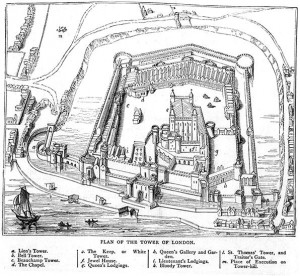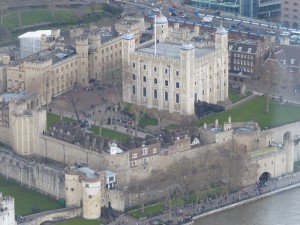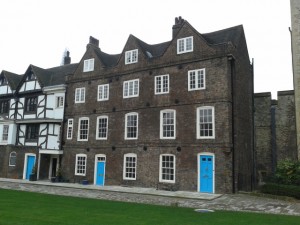The author of ‘The Chronicle of Queen Jane’ dines with Lady Jane.
‘The fortress would become in rapid succession her palace, her prison, her scaffold – and her tomb.’ (p.229, Jones)
On the 29th August 1553, Rowland Lee, ‘an official at the Royal Mint’ (p.133, de Lisle) and the author of ‘The Chronicle of Queen Jane and of Two Years of Queen Mary, and Especially of the Rebellion of Sir Thomas Wyat’, dined at Nathaniel Partridge’s house where Lady Jane was being held. The author was surprised to find Jane seated at the table when he arrived and afterwards recorded their conversation in his chronicle.
Eric Ives writes, ‘We do not know what Lea’s religious opinions were, but the meeting with Jane may have been responsible for the considerable interest his account appears to have taken in her future.’ (p.251, Ives).
See Location
‘Note, that on tuisdaie the xxixth of Auguste, I dyned at Partrige’s house with my lady Jane, being ther present, she sitting at the bordes end, Partige, his wife, Jacob my ladyes gentill woman, and hir man. She commanding Partrige and me to put on our capes, emongest our communycacion at the dyner, this was to be noted: after she had one or twice droncke to me and bad me hartellie welcome, saithe she, “The queens majesty is a merciful princes; I beseche God she may long continue, and sende his bountefull grace apon hir.” After that, we fell in…mattiers of religion; and she axed what he was that preched at Polles on sonday before; and so it was tolde hir to be one… “I praie you,” quod I, “in some places.” “Yt may so be,” quod she, “yt is not so strange as the sodden convertyon of the late duke; for who woulde have thought,” saide she, “he would have so don?” Yt was aunwered her, “Perchance he thereby hoped to have had his pardon.” “Pardon?” quod she; “wo worthe him! he hath brought me and our stocke in most miserable callamyty and mysery by his exceeding ambicion. But for th’ aunswering that he hoped for life by his tourning, thoughe other men be of that opinion, I utterly am not; for what man is ther lyving, I pray you, although he had been innocent, that wolde hope of life in that case; being in the felde ageinst the queen in person as generall, and after his taking so hated and evell spoken of by the comons? and at his coming into prison so wonderyed at as the like was never harde by any man’s tyme. Who was judge that he shoulde hope for pardon, whose life was odyous to all men? But what will ye more? Like as his life was wicked and full of dissimulaciom, so was his ende thereafter. I pray God, I, nor no frende of myne, dye so. Shoulde I, who (am) yonge and in my fewers, forsake my faythe for the love of lyfe? Nay, God forbed: moche more he should not, whose fatall course allthoughe he had lyved his just noumber of yeres, could not have long continued. But life was swete, it appeered; so he might have lyved, you will saye, he dyd (not) care howe. Indede the reason is goode; for he that wolde have lyved in chaynes to have had his lyfe, by like wold leave no other meane attempted. But God be mercyfull to us, for he sayeth, Whoso denyeth him before men, he will not knowe him in his Father’s kingdome.” With this and moche like talke the dyner passyd away; which ended, I thanked her ladyship that she would witsafe accept me in hir companye; and she thancked me likewise, and sayd I was wellcoem. She thancked Partrige also for brining me to dyner. “Madam,” saide he, “wee wer somewhat bolde, not knowing that your ladyship dyned belowe untyll we fonde your ladyship ther.” And so Partrige and I departed.’ (p.24-26, Nichols)
Location
The Tower of London is in central London on the north bank of the Thames.

From ‘A view of London, Westminster and Southwark, as they appeared A.D. 1543. 19th Century engraving by Nathaniel Whittock from a drawing by Antony van den Wyngaerde’
Wikimedia Commons
The Queen’s House was formerly the Lieutenant’s Lodgings and Nathaniel Partridge’s house is between c – the Beauchamp Tower (where Guildford Dudley was held) and i – the Lieutenant’s Lodging
Some Key Dates in the Tudor History of the Tower of London
‘1503 – 11 February – Queen Elizabeth of York dies just over a week after giving birth.
1509 – 21 June – King Henry VIII arrives at the Tower to prepare for his coronation.
1536 – 19 May – Anne Boleyn is executed.
1542 – 13 February – Katherine Howard and Lady Jane Rochford are executed.
1547 – 19 February – King Edward VI leaves for his coronation procession.
1553 – 10 July – Queen Jane takes possession of the Tower.
1553 – 19 July – Queen Jane’s reign ends at the Tower.
1553 – 3 August – Queen Mary I takes possession of the Tower.
1553 – 22 August – John Dudley, Duke of Northumberland is executed.
1553 – 29 August – The author of the ‘Chronicle of Queen Jane etc’ dines with Lady Jane at Nathaniel Partridge’s house.
1554 – 12 February – Lady Jane and Lord Guildford Dudley are executed.
1554 – 23 February – Henry Grey, Duke of Suffolk is executed.
1558 – 12 January – Elizabeth I arrives to prepare for her coronation.’
From ‘On This Day in Tudor History by Claire Ridgway.’
The Tower of London Today
Sources
De Lisle, L. (2010) The Sisters Who Would Be Queen: The Tragedy of Mary, Katherine and Lady Jane Grey, HarperPress.
Ives, E. (2009) Lady Jane Grey: A Tudor Mystery, Wiley-Blackwell.
Jones, N. (2011) Tower: An Epic History of the Tower of London, Windmill Books
Nichols, J. G (ed) (1850) The Chronicle of Queen Jane and of Two Years of Queen Mary and Especially of the Rebellion of Sir Thomas Wyatt, Written by a Resident in the Tower of London, Llanerch Publishers
Ridgway, C. (2012) On This Day in Tudor History, Made Global Publishing.
The Anne Boleyn Files – Places
Wikipedia – Panorama of London




































